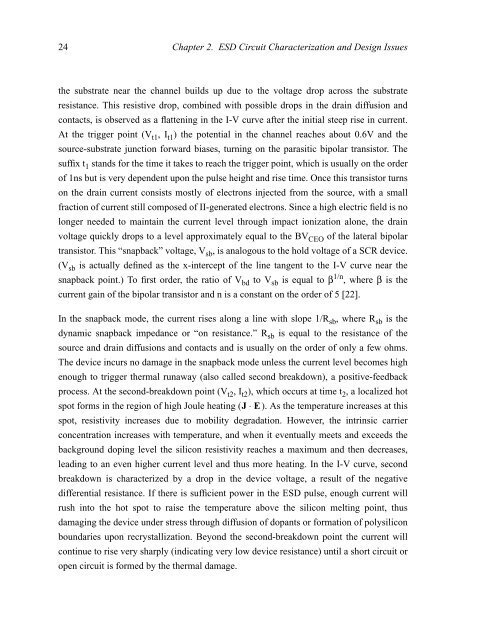characterization, modeling, and design of esd protection circuits
characterization, modeling, and design of esd protection circuits
characterization, modeling, and design of esd protection circuits
Create successful ePaper yourself
Turn your PDF publications into a flip-book with our unique Google optimized e-Paper software.
24 Chapter 2. ESD Circuit Characterization <strong>and</strong> Design Issues<br />
the substrate near the channel builds up due to the voltage drop across the substrate<br />
resistance. This resistive drop, combined with possible drops in the drain diffusion <strong>and</strong><br />
contacts, is observed as a flattening in the I-V curve after the initial steep rise in current.<br />
At the trigger point (Vt1 , It1 ) the potential in the channel reaches about 0.6V <strong>and</strong> the<br />
source-substrate junction forward biases, turning on the parasitic bipolar transistor. The<br />
suffix t1 st<strong>and</strong>s for the time it takes to reach the trigger point, which is usually on the order<br />
<strong>of</strong> 1ns but is very dependent upon the pulse height <strong>and</strong> rise time. Once this transistor turns<br />
on the drain current consists mostly <strong>of</strong> electrons injected from the source, with a small<br />
fraction <strong>of</strong> current still composed <strong>of</strong> II-generated electrons. Since a high electric field is no<br />
longer needed to maintain the current level through impact ionization alone, the drain<br />
voltage quickly drops to a level approximately equal to the BVCEO <strong>of</strong> the lateral bipolar<br />
transistor. This “snapback” voltage, Vsb , is analogous to the hold voltage <strong>of</strong> a SCR device.<br />
(Vsb is actually defined as the x-intercept <strong>of</strong> the line tangent to the I-V curve near the<br />
snapback point.) To first order, the ratio <strong>of</strong> Vbd to Vsb is equal to β 1/n , where β is the<br />
current gain <strong>of</strong> the bipolar transistor <strong>and</strong> n is a constant on the order <strong>of</strong> 5 [22].<br />
In the snapback mode, the current rises along a line with slope 1/Rsb , where Rsb is the<br />
dynamic snapback impedance or “on resistance.” Rsb is equal to the resistance <strong>of</strong> the<br />
source <strong>and</strong> drain diffusions <strong>and</strong> contacts <strong>and</strong> is usually on the order <strong>of</strong> only a few ohms.<br />
The device incurs no damage in the snapback mode unless the current level becomes high<br />
enough to trigger thermal runaway (also called second breakdown), a positive-feedback<br />
process. At the second-breakdown point (Vt2 , It2 ), which occurs at time t2 , a localized hot<br />
spot forms in the region <strong>of</strong> high Joule heating ( J⋅E). As the temperature increases at this<br />
spot, resistivity increases due to mobility degradation. However, the intrinsic carrier<br />
concentration increases with temperature, <strong>and</strong> when it eventually meets <strong>and</strong> exceeds the<br />
background doping level the silicon resistivity reaches a maximum <strong>and</strong> then decreases,<br />
leading to an even higher current level <strong>and</strong> thus more heating. In the I-V curve, second<br />
breakdown is characterized by a drop in the device voltage, a result <strong>of</strong> the negative<br />
differential resistance. If there is sufficient power in the ESD pulse, enough current will<br />
rush into the hot spot to raise the temperature above the silicon melting point, thus<br />
damaging the device under stress through diffusion <strong>of</strong> dopants or formation <strong>of</strong> polysilicon<br />
boundaries upon recrystallization. Beyond the second-breakdown point the current will<br />
continue to rise very sharply (indicating very low device resistance) until a short circuit or<br />
open circuit is formed by the thermal damage.
















